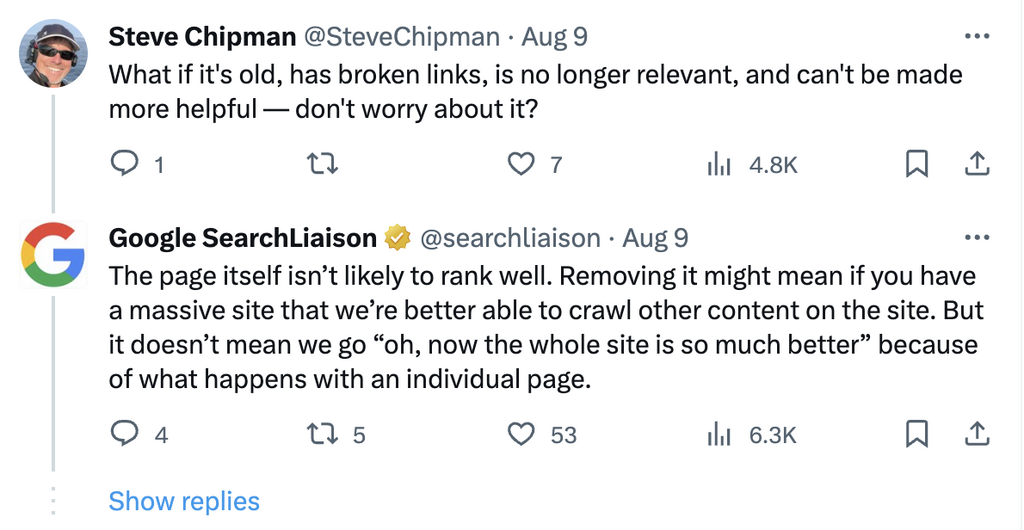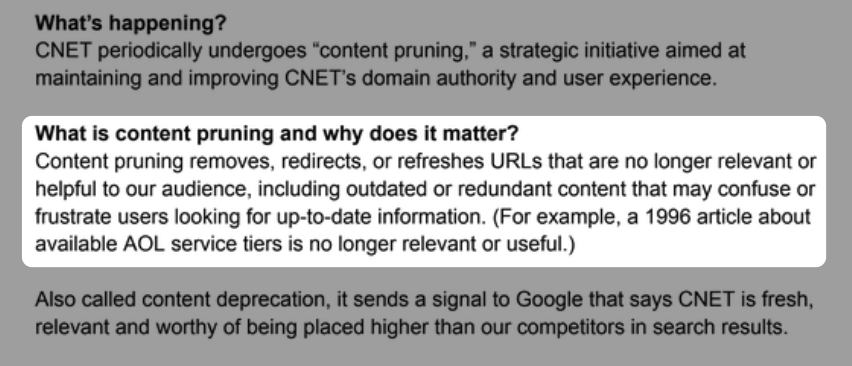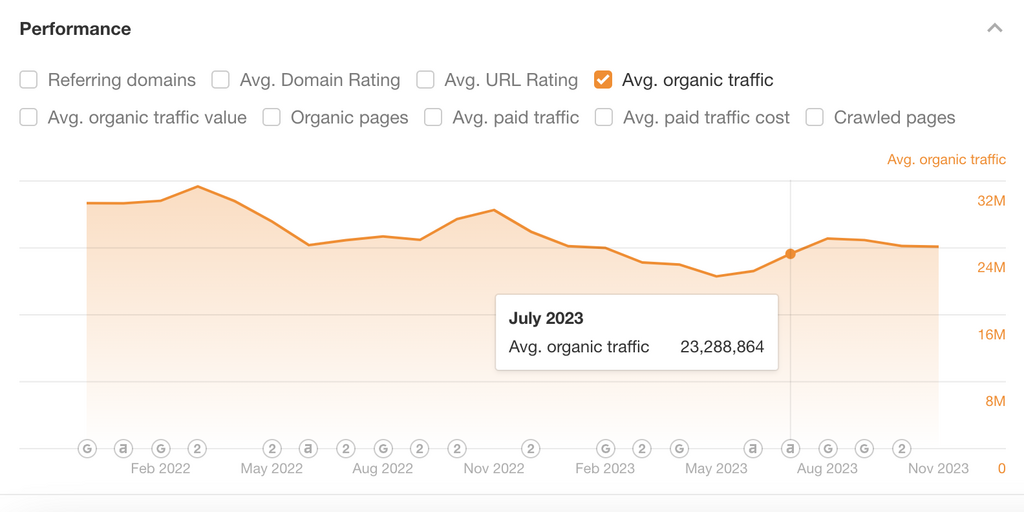Google rewards quality, evergreen content that helps readers learn, and find answers to their most pressing questions.
But what impact does removing thin or low quality content have on your website's organic performance?
The "SEO pruning" approach – also known as "content pruning" or "content culling" – has become popular over the years.
It involves removing, redirecting, or even deindexing underperforming pages to make a site stronger.
But does it actually work?
Or can pruning actually be harmful to the performance of your content marketing?
What is content pruning, and where did the concept originate?
As previously mentioned, content pruning is the process of removing or redirecting low-quality, outdated, or underperforming content from a website to improve overall quality and performance.
This strategy originated from the idea of pruning a bonsai tree – when you cut or remove dead branches and leaves, you can increase the tree's overall health, and make sure all of its energy goes toward the parts you want to grow.
Many SEOs feel this concept applies to websites and SEO performance.
So, is low-quality or outdated content to blame for a website underperforming in Google search?
Managing Editor of Search Engine Land, Danny Goodwin, published an article stating that low-quality content isn't defined as the date it was published.
Nothing is that simple – there are many other factors at play.
It wasn't until 2023 that this website optimization tactic came under fire and made headlines, when news outlet CNET deleted thousands of older articles from its site, telling staff the deletions would improve its Google search ranking, according to an internal memo.
What are the risks of content pruning?
If you decide to undertake content pruning – whether that be through deleting, redirecting, or de-indexing articles – you risk removing:
- Internal links that raise up the rest of the content in your portfolio
- Anchor text that helps it rank for semantically related traffic
- Backlinks from external sites that are referencing this content
- Topical authority in both the eyes of the algorithm and the reader
That’s why you need to carefully weigh up the benefits and disadvantages of pruning your content.
If you’re going to lose important internal links, you need a plan to replace them.
If you’re losing backlinks, you might need to do outreach to win back lost references.
If you’re going to lose topical authority on a subject that is still relevant and important, then perhaps you shouldn’t be pruning at all.
CNET's content pruning issues and backlash
A reporter named Thomas Germain published a bombshell investigative journalism piece for Gizmodo based on an internal memo from CNET that they "deleted thousands of old articles over the past few months, in a bid to improve its performance in Google search results."
Google Search Liaison Danny Sullivan directly refuted CNET's claims that this was an effective strategy in a tweet he posted just ahead of Germain's story.
He clarified that removing or even updating "old" content doesn’t mean the remaining content on the site is viewed more positively in the eyes of Google.
Google has repeatedly emphasized against deleting old content after CNET deleted thousands of old archive pages.
The pruning adds to recent controversies over CNET's editorial cost-cutting, including:
- Layoffs
- Focusing on profits from referral links
- Experiments with error-riddled articles written by AI chatbots
In his article "The CNET Lesson: Content Pruning Is Dumb For News Content, Don't Do It", Ernie Smith pointed out that pruning news content at such a scale removes important historical context that future researchers and journalists can use to tell important stories.
He also mentioned that CNET was not the first news site to prune its archives, or make them hard to access.
As an example, he pointed out that USA Today, which has been online for 27 years, has a sitemap that only goes back to October of 2012.
It is the same with Newsweek, which only has an archive page that covers issues dating back to 2013.
On the flip side, he mentioned that other news media sites such as NYT, the Washington Post, and Time do a thoughtful job of making the archive content accessible.
The $M question: Should you prune your content?
In the case of CNET, some SEOs have argued that its content pruning faux pas have been sensationalized by Google and in the press.
In its memo, CNET did not state it would arbitrarily delete content, but instead selectively remove, redirect, or refresh content that was no longer relevant to its readers.
And when you look at the impact of those content pruning decisions on organic traffic, it does not seem to have hurt the site.
If anything, CNET has seen a slight uplift in organic traffic since it started content pruning in July, according to Ahrefs. Not quite enough to take it back to the hey-days of Feb 2022, but an uptick nonetheless.
Veteran SEO, Barry Adams, shares some sage advice on content pruning in the Slack community NewsSEO, stating that it’s a very context-dependant activity:
"Many SEOs have been proclaiming the virtues of content pruning for many years, with some anecdotal evidence to back up its success, but there have been plenty of instances where the evidence was very thin, and even where content pruning caused disaster. So it's not an 'industry-wide best practice.' It's just another tool in a very broad arsenal, and a tool that needs to be applied only when it is the right tool for the job. And that is very context-dependent."
Ulrik Baltzer, SEO Manager at TV 2 Danmark, believes content consolidation is preferential to content pruning:
"Personally, I think [CNET] could stick to 1+2 in their content pruning process without deprecating [content]. By consolidating articles without deprecating unnecessarily, they could retain topical authority and focus their editorial efforts on fewer and better articles going forward. It's like consolidating ten different stories about the history of CPUs into one mother article or something along those lines. But it depends on your perspective, I guess."
But perhaps the best advice I’ve seen, in relation to following SEO best practices, actually came from a job posting I saw two months ago on LinkedIn:
"Don't accept theories at face value, and enjoy testing to prove the effectiveness of tactics."
Test, test, and test again!
How to prune your content in 3 steps
1. Audit your site to find struggling content
Start off by auditing your content. Determine which pieces are struggling based on performance drops over time, across:
- Sessions
- Engaged sessions
- Keywords
- Rankings
- Backlinks
- Shares
- Average engagement time per session
- Conversions
You should also do a site search on Google for mentions of old dates or news topics in your content.
This content will likely need to be updated or pruned.
2. Identify your quick win updates
Zero in on content that has experienced recent drops. If this content is
- Still bringing in traffic via channels beyond search
- Showing strong metrics beyond rankings (ie. shares, engagement time)
- Ranking on the bottom of page one, or top of page 2
Then it is showing signs of life and potential – meaning audiences and search engines are still deeming it to be relevant.
This is content you ideally want to be updating and optimizing.
3. Assign a pruning action to the rest of your content
For content showing little to no performance, you need to make a decision on whether to:
- Consolidate/merge it with another piece of related content
- Redirect it to a newer, more relevant piece of content
- Remove it entirely from your site – if there really is no value and it can't be upcycled or archived
- De-index it so it can’t be crawled by search engines
Wrapping up
When you set out to prune your content, it’s important to ask yourself a couple of questions.
Is your content really relevant to your target audience? In pursuing growth, be careful to maintain sight of your core audience in favor of publishing content about anything and everything. Stay true to your identity and your audience.
Is your content helping you achieve a goal? Make sure you can tie every piece of content to a specific goal (ie. to rank, attract links, drive conversions). Otherwise you’re just creating content for content’s sake.
Maintain your content well, and you'll reap the rewards.
Categories
SEOCategories
SEOThe Monthly Buzz⚡
Subscribe to BuzzSumo's monthly newsletter to:
Stay up-to-date with the best of the best in content marketing 📝
Get data-informed content, tips and tidbits insights first 👩🏻💻
Read top shared content by top marketing geeks 🤓
Try
Enter any topic, term or url to search to see BuzzSumo in action. It’s free!
100% free. No credit card required.




